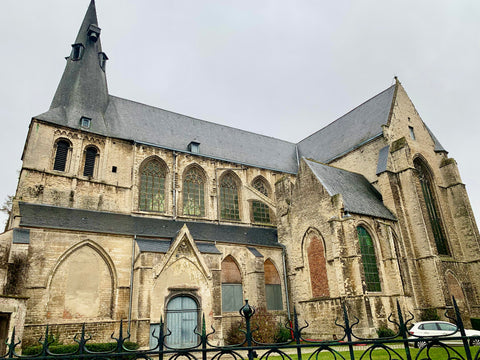The Seven Ancient Wonders of Leuven
In his 1895 book “Louvain dans le passé et dans le présent”, Edward Van Even described the Seven Wonders of Leuven, inspired by the 19th-century romantic tradition of attributing extraordinary features to historic cities. Much like Rome’s seven hills, these wonders enhanced Leuven’s cultural and historical image.
1. The Living Pass Under the Dead (De Levenden gaen onder de dooden)
At St. Michele’s Gate on Tiensestraat, a part of the church was built above the gate. Pedestrians walking through passed beneath the graves inside the church. Both the gate and church were demolished in 1781.
2. The People Pass Under the Roots of the Tree (De menschen gaan onder de wortels der boomen)
Near the Tervuren Gate stood a bulwark with elm trees above its arch. Passersby walked beneath the trees, appearing to move under their roots. This gate was removed in 1829.
3. The Altar Outside the Church (Den autaer buiten de kerk)
The façade of St. Michele Church on Naamsestraat (formerly the Jesuit Church) was designed like a 17th-century altar by architect Guillaume Hesius. Built between 1656 and 1666, it remains a unique feature in Leuven.
4. The Bell Outside the Tower (De klock buiten den toren)
In 1478, Jean van Henegauwe of Mechelen cast a bell for St. James Church. To improve its sound, it was placed outside the tower—an unusual practice for the time.
5. The Tower Without Nails (De toren zonder negels)
The tower of St. Gertrude’s Church, designed by Jean van Ruysbroec, was famed for its intricate openwork stone spire, supposedly built by dwarves. Unlike other towers, it was left uncovered by slats.
6. The Tower Lower Than the Church (De toren lager dan de kerk)
At the Convent of the Discalced Carmelites, a small wooden tower above the sacristy stood lower than the church roof itself. After the convent was dissolved in 1783, the structure was demolished in 1808. A reminder of this wonder can still be found in the tabernacle tower of St. Peter’s Church.
7. The River Flowing Backwards
Van Even also noted the unusual flow of the Dijle River at St. Gertrude’s Lock, where water would reverse direction when the lock closed. This phenomenon was tied to the legend of Saint Fiere Margriet, whose body was said to have floated upstream after her death.
Source: Leuven Anno2005, Uitgeverij Lannoo, Tielt, Belgium),
photo by Aslı Tezcan.



